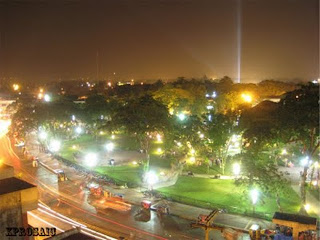General Santos City is proud to be the “Tuna Capital of the Philippines”. Aside from tunas, the city has also other things to be proud of. The tourist spots and festivals of General Santos City make it a great destination for tourists.
A tourist attraction in General Santos City is a social gathering festival called Kalilangan sa Heneral Santos. Kalilangan is from the word “Kalilang” meaning commemoration or celebration according to the Maguindanaon dialect.
 The people of General Santos City gather socially for this festival where they exchange amenities among native leaders, ally, elders, and subordinates. The festival is a pageantry of various colorful ethnic rites, traditions, and rituals such as religious ceremonies, marriage celebrations, anniversaries, enthronement of royal dignitaries, funerals, thanksgiving, and other social activities.
The people of General Santos City gather socially for this festival where they exchange amenities among native leaders, ally, elders, and subordinates. The festival is a pageantry of various colorful ethnic rites, traditions, and rituals such as religious ceremonies, marriage celebrations, anniversaries, enthronement of royal dignitaries, funerals, thanksgiving, and other social activities.
The Kalaja Karsts Area is a wonderful destination for tourists in General Santos City. The area is about 15 kilometers from General Santos City’s northeast side at Barangay Conel. The name Kalaha Karsts Area is derived from the word Kalaha, which means frying pot due to the formation of the karsts made millions of years ago. Waterfalls and caves are abundant in this area.
A tourist attraction in General Santos City is a social gathering festival called Kalilangan sa Heneral Santos. Kalilangan is from the word “Kalilang” meaning commemoration or celebration according to the Maguindanaon dialect.
 The people of General Santos City gather socially for this festival where they exchange amenities among native leaders, ally, elders, and subordinates. The festival is a pageantry of various colorful ethnic rites, traditions, and rituals such as religious ceremonies, marriage celebrations, anniversaries, enthronement of royal dignitaries, funerals, thanksgiving, and other social activities.
The people of General Santos City gather socially for this festival where they exchange amenities among native leaders, ally, elders, and subordinates. The festival is a pageantry of various colorful ethnic rites, traditions, and rituals such as religious ceremonies, marriage celebrations, anniversaries, enthronement of royal dignitaries, funerals, thanksgiving, and other social activities.The Kalaja Karsts Area is a wonderful destination for tourists in General Santos City. The area is about 15 kilometers from General Santos City’s northeast side at Barangay Conel. The name Kalaha Karsts Area is derived from the word Kalaha, which means frying pot due to the formation of the karsts made millions of years ago. Waterfalls and caves are abundant in this area.










